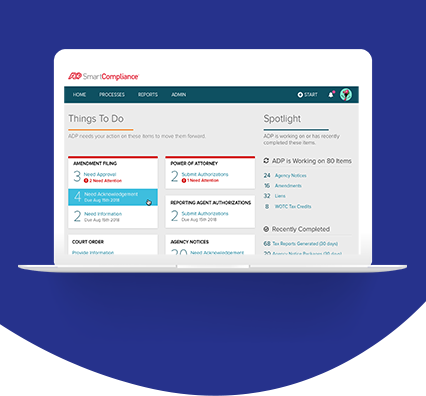The Work Opportunity Tax Credit is a federal tax credit available to employers who hire and retain qualified veterans and other individuals from target groups that historically have faced barriers in securing employment. By creating economic opportunities, this program also helps lessen the burden on other government assistance programs.
How does the Work Opportunity Tax Credit program work?
Taxable employers and qualified tax-exempt companies who hire someone that is a member of a WOTC target group can apply for a general business credit against their income tax.

Work Opportunity Tax Credit certification and screening process
Before employers can claim a Work Opportunity Tax Credit, they must first receive certification from a State Workforce Agency (SWA) that the new hire meets the qualifications of one of the target groups. This is done using IRS Form 8850 and one of two forms from the Department of Labor.
The first, ETA Form 9061, or the Individual Characteristics Form (ICF), provides specific information about how an applicant answered the WOTC questionnaire. The second, ETA Form 9062, is the Conditional Certification Form for applicants who have been pre-screened for WOTC by an SWA. Both forms must accompany Form 8850 submissions.
Form 8850
Employers have 28 days from a qualified employee’s start date to send Form 8850, also known as the Pre-Screening Notice and Certification Request for the WOTC, to the applicable SWA. The first page, which needs to be completed by the applicant on or before the day of the job offer, outlines the conditions that someone from one of the target groups must meet to qualify for the program. The second page is intended for employers. On it, they will provide their business contact information and the applicant’s key employment-related dates.
Work Opportunity Tax Credit questionnaire
Page one of Form 8850 is the WOTC questionnaire. It asks the applicant about any military service, participation in government assistance programs, recent unemployment and other targeted questions.
Who qualifies for the Work Opportunity Tax Credit?
Employers may qualify for the WOTC if they hire an individual who is a member of one of the target groups determined by the IRS to have historically faced barriers to employment.
Employees eligible under the Work Opportunity Tax Credit program
The following groups are considered target groups under the WOTC program:
- Qualified short-term and long-term IV-A recipients (Temporary Assistance for Needy Families)
- Qualified veterans
- Ex-felons
- Designated community residents (DCR)
- Vocational rehabilitation referrals
- Summer youth employees
- Supplemental Nutrition Assistance Program (SNAP) recipients
- Supplemental Security Income (SSI) recipients
- Qualified long-term unemployment recipients
Employees not eligible under the Work Opportunity Tax Credit program
Some exclusions apply to the list of WOTC target groups. Employers who rehire a former employee, a family member or dependent, or someone who will be a majority owner in the business may not be able to claim the tax credit for that individual (even if the individual is otherwise a member of an eligible target group).
Businesses eligible for the Work Opportunity Tax Credit
Any business, regardless of size or industry, may be eligible to claim tax credits under the WOTC program. And because there’s no limit to the number of individuals employers can hire as part of the program, there’s also no cap on the amount of credits that they can claim.
How do employers claim the Work Opportunity Tax Credit?
- Find eligible applicants
Contact the SWA or local unemployment office for a list of potential job applicants. - Screen applicants
Have applicants complete the questionnaire on the first page of Form 8850 on or before the job offer date to see if they qualify for one of the WOTC target groups. - File documents
Submit the completed Form 8850 and either ETA Form 9061 or 9062 to the SWA within 28 days of the eligible new hire’s start date. - Monitor hours worked and qualified wages paid
WOTC-certified employees must work at least 120 hours during the first year of employment for an employer to claim credits, which are calculated as a percentage of qualified wages. Employees in the TANF recipient category must work 400 hours. - Claim the tax credit
Use IRS Form 5884 when filing annual tax returns to claim the WOTC. - Keep accurate records
Make copies of all the forms and supporting documents submitted to SWAs and correctly track employee hours in case the IRS decides to audit the credits claimed.
Benefits of outsourcing tax credits and business incentives administration
Both newly eligible business that haven’t yet taken advantage of tax credits and those that already have a large tax credit portfolio may benefit from outsourcing tax credits. It can help them:
- Identify and evaluate new opportunities for which they may be eligible
- Maintain accurate records so they can make informed decisions backed by data
- Stay compliant with changing tax credit laws and avoid penalties
- Report tax credit activities and meet deadlines
How ADP can help employers navigate the Work Opportunity Tax Credit program
ADP’s web-based WOTC screening system improves screening compliance rates and simplifies data collection. It uses plain language and automatically skips sections of the WOTC questionnaire that may be irrelevant, helping applicants complete the form quickly and correctly. We also offer benchmarking and analytics tools that can help employers forecast their tax credits.
ADP saves time and reduces stress for Work Opportunity Tax Credit clients
Switching from a manual Work Opportunity Tax Credit screening process to ADP’s automated solution can help minimize the workload of hiring managers. It works on most mobile devices, so there’s less paperwork and it has applicant-friendly features that make it more likely for applicants to complete the WOTC questionnaire.
What differentiates ADP from other Work Opportunity Tax Credit providers?
ADP screens over 34 million applicants per year for the WOTC program*. With that level of experience across different industries, we’re uniquely positioned to help employers identify and apply for tax credits while maintaining compliance.
*Source: ADP Internal Data, 2019.
Work Opportunity Tax Credit FAQs
See what other employers are asking about the WOTC:
How much is the Work Opportunity Tax Credit?
The amount of the tax credit available under the WOTC program varies based on the employee’s target group, total hours worked and total qualified wages paid. As of 2020, most target groups have a maximum credit of $2,400 per eligible new hire, but some may be higher. Hiring certain qualified veterans, for instance, may result in a credit of $9,600 per eligible new hire.
Does the Work Opportunity Tax Credit benefit employees?
Although the tax credit only applies to employers, the WOTC program may benefit employees by making career opportunities available to those who otherwise might have had a hard time landing a job. Such individuals include ex-felons, veterans and food stamp recipients.
What Work Opportunity Tax Credit integrations does ADP offer?
ADP’s automated WOTC solution seamlessly integrates with most recruiting and hiring software and applicant tracking systems (ATS).
Is participation in the Work Opportunity Tax Credit program mandatory?
The Work Opportunity Tax Credit is a voluntary program. As such, employers are not obligated to recruit WOTC-eligible applicants and job applicants don’t have to complete the WOTC eligibility questionnaire. Employers can still hire these individuals if they so choose, but will not be able to claim the tax credit.
This article provides practical information concerning the subject matter and is provided with the understanding that ADP is not rendering legal or tax advice or other professional services.




